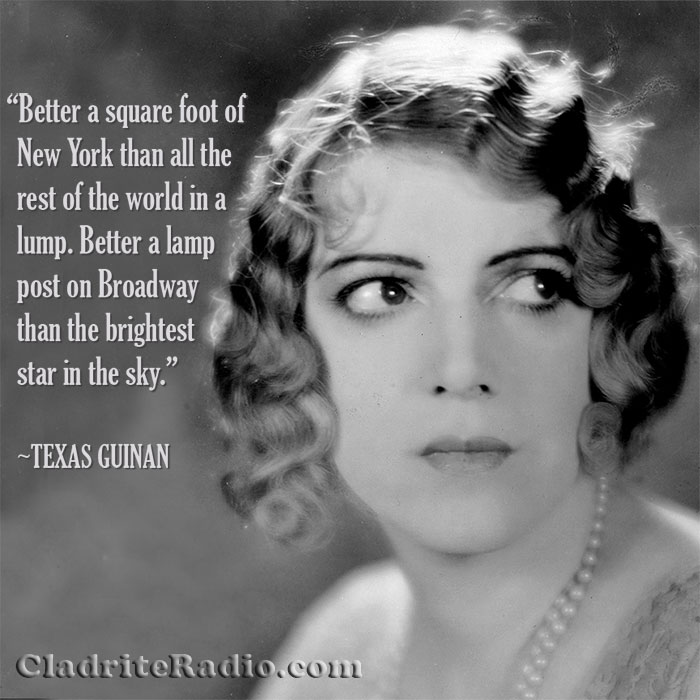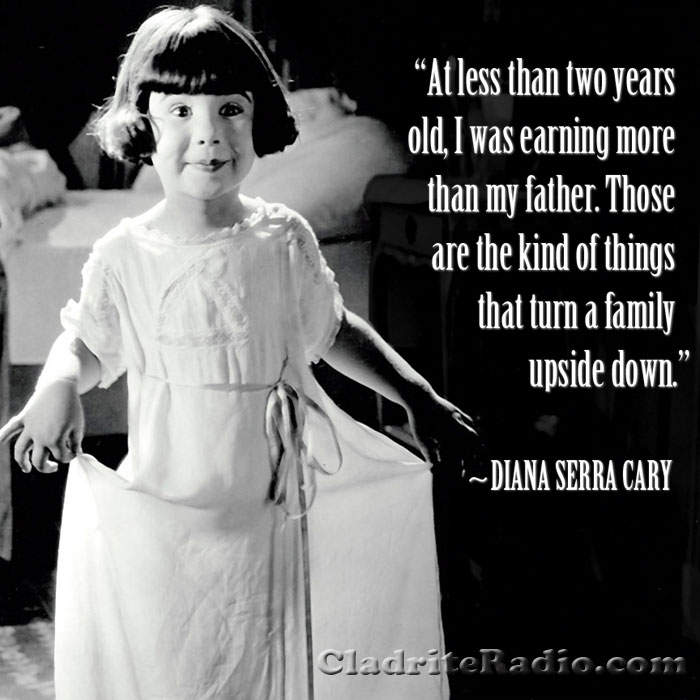Here are 10 things you should know about actor Ben Lyon, born 122 years ago today. He enjoyed as much success in England as he did in the United States.
Tag: Pola Negri
10 Things You Should Know About Rockliffe Fellowes
Here are 10 things you should know about Rockliffe Fellowes, born 139 years ago today. He began his career on the stage and made more than 60 movies over a 20-year film career.
Happy 133rd Birthday, Texas Guinan!
Actress and Queen of the Nightclubs Texas Guinan was born Mary Louise Cecilia Guinan 133 years ago today in Waco, Texas. Here are 10 TG Did-You-Knows:
- Guinan was one of seven children. Her parents were Irish-Canadian immigrants. She attended parochial school at a Waco convent.
- When Guinan was 16, her parents moved the family to Denver, Colorado. There she began to appear in amateur stage productions before marrying newspaper cartoonist John Moynahan at age 20. The pair moved to Chicago, where she studied music. She eventually divorced Moynahan and began to perform in vaudeville as a singer.
- Guinan’s singing was reportedly no great shakes, but she had lots of pep and she soon found that she improved her prospects as a performer by regaling the audience with (perhaps exaggerated) tales of her “Old West” upbringing.
- In 1906, Guinan moved to New York City, where she worked as a chorus girl before finding additional work in vaudeville and on the New York stage.
- In 1917, Guinan made her movie debut and soon was a regular in western pictures. She is said to have been the first movie cowgirl (her nickname was The Queen of the West). Guinan would go on to appear in more than 50 features and shorts before she died in 1933.
- With the passage of the 18th Amendment, Guinan became active in the speakeasy industry, serving as hostess and emcee for a long string of illicit (but very popular) nightspots. Her outsized, sassy personality and her skill at evading justice, despite her many arrests for operating a speakeasy, made her a legendary figure in Prohibition-era NYC.
- Guinan’s speakeasies featured an abundance of scantily clad fan dancers and showgirls, but her penchant for pulling the legs of the rich and famous served her just as well. “Hello, suckers!” became her standard exclamation for greeting customers. Her well-to-do patrons she referred to as her “butter-and-egg men” and she coined the familiar phrase “Give the little ladies a big hand” while serving as emcee.
- Texas Guinan’s nightclubs were often backed by gangster Larry Fay and such legendary bad guys as Arnold Rothstein, Owney Madden and Dutch Schultz frequented her establishments—alongside relatively “good guys” such as George Gershwin, Walter Chrysler, Pola Negri, Mae West, Al Jolson, Gloria Swanson, John Gilbert, Clara Bow, Irving Berlin, John Barrymore and Rudolph Valentino.
- Ruby Keeler and George Raft both got their starts in show business as dancers as Guinan’s clubs, and Walter Winchell acknowledged that the inside access Guinan gave him to Broadway’s cornucopia of colorful characters helped launch his career as a gossip columnist.
- Guinan died of amoebic dysentery in 1933, one month before Prohibition was repealed. She was just 49. Bandleader Paul Whiteman and writer Heywood Broun were among her pallbearers.
Happy birthday, Texas Guinan, wherever you may be!

Happy 98th Birthday, Diana ‘Baby Peggy’ Serra Cary!
Sadly, there are very few stars of the silent era who are still with us today, but Diana Serra Cary, born Peggy-Jean Montgomery 98 years ago today in San Diego, was, as Baby Peggy, a bona fide star in her day. Here are 10 DSC/BP Did-You-Knows:
- Peggy’s father, Jack Montgomery, worked as a cowboy for some years before entering the movie business, working as a stuntman and extra. He eventually did some stand-in work for western star Tom Mix.
- Young Peggy-Jean was discovered at the age of 19 months when she accompanied her mother to visit her father, who was working at Century Studios in Hollywood. Director Fred Fishbach (later Fred Hibbard), impressed by her demeanor and ability to take direction (from her parents, that is), cast her in a short subject opposite Century’s popular canine star, Brownie the Wonder Dog. Baby Peggy’s picture debut was in Playmates (1921). When it proved a success, she was signed to a long-term contract.
- From 1921 to 1924, Peggy appeared in nearly 150 comedy shorts for Century. These films were often parodies of other popular movies of the day, so Peggy was sometimes asked to satirize popular stars (she did take-offs on both Rudolph Valentino and Pola Negri in Peg o’ the Movies [1923]).
- In 1923, Peggy began to appear in full-length dramatic features for Universal. These films were “A” pictures, dubbed “Universal Jewels,” the studio’s designation for its top-shelf offerings.
- In 1922, Peggy received more than 1.2 million fan letters. She was so popular that between pictures, she was sent on nationwide promotional tours, making public appearances along the way to promote her movies.
- By 1923, Universal was paying Peggy $1.5 million a year (more than $20 million today). Her face also appeared on a wide range of commercial products, from dolls in her likeness to sheet music, jewelry and milk. It’s said that as a girl, Judy Garland owned a Baby Peggy doll.
- You can probably guess the rest of the story: Her parents blew through all that money Peggy was earning, putting nothing aside for her. Her movie career came to a halt in 1925 (she was all of seven years old) when her father had a falling out with a producer over her salary and cancelled her contract. She was successful in vaudeville for a few years thereafter, but with a stage name like Baby Peggy, her career was bound to trail off. It was a relief to her when her career slowed down, but her parents relied on her for their income and kept the pressure on her, so she returned to pictures, playing bit parts and doing extra work.
- Finally, in 1938, Peggy appeared in her last film, Having Wonderful Time, and married Gordon Ayres, after which she changed her name to Diana Ayres (and then to Diana Serra Cary when she converted to Catholicism and remarried—Serra is her confirmation name, and her second husband was named Robert “Bob” Cary).
- In her later years, Diana has authored several books, among them The Hollywood Posse: The Story of a Gallant Band of Horsemen Who Made Movie History, Hollywood’s Children: An Inside Account of the Child Star Era, Jackie Coogan: The World’s Boy King: A Biography of Hollywood’s Legendary Child Star and her autobiography, What Ever Happened to Baby Peggy: The Autobiography of Hollywood’s Pioneer Child Star.
- These days, Diana lives in Gustine, California. There was a push recently for her to be allowed to reside at the Motion Picture & Television Fund’s Woodland Hills retirement facility, but she is in good health, physically and mentally and wanted to remain in California’s Central Valley, near her son and his family. What she needed was financial assistance, not a residence. If you’d like to help her out, you can buy one or more of her acclaimed books (she’s a very good writer), you can send her a Paypal donation using the email address BabyPeggy1920 at att.net (her son oversees that account), or you can send her a card with a check to 738 Fifth Avenue, Gustine, CA 95322.
Happy birthday, Diana Serra Cary, and many happy returns of the day!

365 Nights in Hollywood: Bunk Boulevard
Jimmy Starr began his career in Hollywood in the 1920s, writing the intertitles for silent shorts for producers such as Mack Sennett, the Christie Film Company, and Educational Films Corporation, among others. He also toiled as a gossip and film columnist for the Los Angeles Record in the 1920s and from 1930-1962 for the L.A. Herald-Express.
Starr was also a published author. In the 1940s, he penned a trio of mystery novels, the best known of which, The Corpse Came C.O.D., was made into a movie.
In 1926, Starr authored 365 Nights in Hollywood, a collection of short stories about Hollywood. It was published in a limited edition of 1000, each one signed and numbered by the author, by the David Graham Fischer Corporation, which seems to have been a very small (possibly even a vanity) press.
Here’s “Bunk Boulevard” from that 1926 collection.
BUNK BOULEVARD
Hollywood Boulevard. . . .
Late afternoon. Women shoppers with tiny beads of perspiration on once powdered noses. Magazines used as fans. Coatless men. Heat waves make a pale blue haze come from the black asphalt. Car tracks glisten in the sun.
Cahuenga Avenue and Hollywood Boulevard . . .
The Forty-second and Broadway of the movie village. A thin man, coatless,but with open vest, smelling of sweat, shouts from across the street:
“Joe, didja’ get me that gang for th’ night shot?”
“Yeh,” comes the hasty answer from someone in the movie crowd.
The thin man scuffs from sight around the corner.
The sun is tired. As it sinks a shadow remains. Shop owners crank up their awnings.
Seven giddy schoolgirls with books and papers make a sudden loud entrance into the drug store. There is a rush for the cosmetic and soda counter. Some believe in interior decorating first.
Four tall glasses with syrup concoctions slide along the marble counter.
One with pimples on her forehead sucks hard on the chocolate in the bottom of the glass.
A rosy-cheeked youth enters in striped flannels.
Five pairs of sparkling eyes greet him.
His cheeks become redder and his chest swells a bit—and probably his head. He has no hat for a test.
There are muffled giggles, and the girl with the prominent teeth lisps something.
A fat lady with a rabbit neck-piece fanning herself with a theatre program has difficulty in getting on the high soda stool.
More giggles.
The youth pays the cashier for a stick of pink make-up.
A man with checkered pants and gaudy shirt calls for a “cherry-coke.”
There is almost a cool breeze outside.
A flivver truck with steaming radiator skids around the corner. The driver dumps out stacks of green evening papers.
Instantly familiar newsboy shouts pierce the hot silence.
A long, heavy under-slung street car rumbles to the corner and stops, discharging groups of high school students.
The screaming brakes on a taxi cab, the sound of sliding rubber on warm pavement, a tiny girlish squeak, a muffled scream of the fat lady and he hoarse cry of the crippled newsboy.
A crowd collects from nowhere. Girls shut their eyes—afraid to look.

